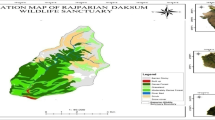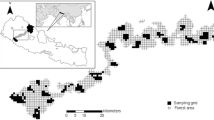Abstract
Habitat quality assessment provides crucial information that can benefit species protection by concentrating conservation resources on specific areas. Unfortunately, such assessments are often rare for avian species in Iran, especially for birds of prey. Here, we modeled the habitat quality of several birds of prey species, including the Egyptian vulture (Neophron percnopterus), Eastern imperial eagle (Aquila heliaca), Saker falcon (Falco cherrug), and Eurasian hobby (Falco subbuteo) in Hamadan province, Iran, based on land use and land cover (LULC) data, distribution of anthropogenic threats, and expert knowledge. Habitat quality maps were then evaluated by applying landscape composition and configuration metrics, which indicated that a large portion of the 3500 km2 study area is highly suitable for A. heliacal (2115.5 km2) and F. cherrug (1658.13 km2) while a much smaller fraction was highly suitable for N. percnopterus (59 km2) and F. subbuteo (90 km2). Landscape metrics analysis also revealed the importance of patch contiguity, density, and fractal dimension for conservation value. Landscape pattern dynamics play a significant role in determining species’ habitat quality and can be informative for biodiversity conservation. Based on our findings, we recommend that the suitable habitats identified in this study be further assessed for ecological protection.





Similar content being viewed by others
Availability of data and materials
The datasets used and/or analyzed during the current study are available from the corresponding author on reasonable request.
References
Akbari A, Pittman J, Feick R (2021) Mapping the relative Habitat Quality values for the burrowing owls (Athene cunicularia) of the Canadian prairies using an innovative parameterization Approach in the InVEST HQ Module. Environ Manage 68(3):310–328
Alfaya P, Casanovas JG, Lobón-Rovira J, Matallanas B, Cruz A, Arana P, Alonso G (2019) Using MaxEnt algorithm to assess habitat suitability of a potential Iberian lynx population in central Iberian Peninsula. Community Ecol 20(3):266–276
Allan JD, McIntyre PB, Smith SD, Halpern BS, Boyer GL, Buchsbaum A, Burton GA, Campbell LM, Chadderton WL, Ciborowski JJ, Doran PJ (2013) Joint analysis of stressors and ecosystem services to enhance restoration effectiveness. PNAS 110(1):372–377
Aneseyee AB, Noszczyk T, Soromessa T, Elias E (2020) The InVEST Habitat Quality Model Associated with land use/cover changes: a qualitative case study of the Winike Watershed in the Omo-Gibe Basin, Southwest Ethiopia. Remote Sens 12(7):1103. https://doi.org/10.3390/rs120711034
Bani Assadi S, Kaboli M, Etemad V, Ghadiri Khanaposhtani M, Tohidifar M (2015) Habitat selection of cavity-nesting birds in the Hyrcanian deciduous forests of northern Iran. Ecol Res 30(5):889–897
Chambers SA (2008) Birds as environmental indicators: review of literature. Parks Victoria Technical Series No. 55. Parks Victoria, Melbourne, Australia
Charney ND, Record S, Gerstner BE, Merow C, Zarnetske PL, Enquist BJ (2021) A test of species distribution model transferability across environmental and geographic space for 108 western north American tree species. Front Ecol Evol 9:689295. https://doi.org/10.3389/fevo.2021.689295
Darvishsefat AA (2006) Atlas of protected areas of Iran. University of Tehran press, Tehran (in Persian)
Department of Environmental Protection of Hamedan Province (2020) Wildlife census of Almobelagh and Khangormoz protected areas, Alvand and Alavi no hunting areas. Unpublished reports (in Persian)
Eastman RJ (2012) IDRISI Selva. Clark Labs, Clark University, Worcester
GBIF (2022) Free and open access to biodiversity data of Iran, datasets. https://www.gbif.org/country/IR/summary. Accessed on 26 Dec 2022
Gustafson EJ (1998) Quantifying landscape spatial pattern: what is the state of the art? Ecosystems 1(2):143–156
Imbeau L, Monkkonen M, Desrochers A (2001) Long-term effects of forestry on birds of the eastern Canadian boreal forests: a comparison with Fennoscandia. Conserv Biol 15(4):1151–1162. https://doi.org/10.1046/j.1523-1739.2001.0150041151.x
IUCN (2022) The IUCN red list of threatened spcies. Version 2022-2. https://www.iucnredlist.org. Accessed on 22 Nov 2022
Jafari A (2013) Ten essential strategies for protecting biodiversity at productive landscape scale (agriculture and forestry). Environ Dev 4(8):5–12 (in Persian)
Kaboli M, Aliabadian M, Tohidifar M, Hashemi A, Musavi SB, Roselaar CC (2016) The Atlas of birds of Iran, 1st edn. Academic Center for Education, Culture and Research Kharazmi branch Press, Tehran (in Persian)
Karimi S, Varasteh Moradi H, Rezaei HR, Brambilla M, Ghadimi M (2018) Fine-scale habitat-use by black woodpecker Dryocopus martius: a year-round study in the Hyrcanian forest, Iran. North-West J Zool 14(1):76–84
Kuemmerlen M, Schmalz B, Guse B, Cai Q, Fohrer N, Jähnig SC (2014) Integrating catchment properties in small scale species distribution models of stream macro invertebrates. Ecol Model 277:77–86
Lawton JH, Gaston KJ (2001) Indicator species. In: Levin S (ed) Encyclopedia of Biodiversity. Academic, San Diego
Leitao AB, Ahern J (2002) Applying landscape ecological concepts and metrics in sustainable landscape planning. Landsc Urban Plann 59(2):65–93
Li X, Hou X, Song Y, Shan K, Zhu S, Yu X, Mo X (2018) Assessing changes of Habitat Quality for shorebirds in Stopover sites: a case study in Yellow River Delta, China. Wetlands 39:67–77
Malavasi M, Bartak V, Carranza ML, Simova P, Acosta ATR (2018) Landscape pattern and plant biodiversity in Mediterranean coastal dune ecosystems: do habitat loss and fragmentation really matter? J Biogeogr 45(6):1367–1377
Management and Planning Organization of Hamedan Province (2016) Statistical Yearbook of Hamedan Province (in Persian)
McAlpine CA, Eyre TJ (2002) Testing landscape metrics as indicators of habitat loss and fragmentation in continuous eucalypt forests (Queensland, Australia). Landsc Ecol 17:711–728
McGarigal K, Cushman SA, Ene E (2012) FRAGSTATS v4: spatial pattern analysis program for categorical and continuous maps. Computer software program produced by the authors at the University of Massachusetts, Amherst. Available at http://www.umass.edu/landeco/research/fragstats/fragstats
Mehri A, Salmanmahiny A, Mirkarimi SH, Rezaei H (2014) A performance comparison of Three Computer algorithms in the selection of best protected areas (Case Study: Mazandaran Province of Iran). J Environ Stud (JES) 40(1):1–16 (in Persian)
Modest RB, Hassan SN, Rija AA (2016) Spatial metrics effect of forest fragmentation on forest bird abundance and site occupancy probability: the influence of patch size and isolation. Ostrich 87(2):131–138
Moradi S, Sheykhi Ilanloo S, Kafash A, Yousefi M (2019) Identifying high-priority conservation areas for avian biodiversity using species distribution modeling. Ecol Indic 97:159–164
Morelli F, Benedetti Y, Šímová P (2018) Landscape metrics as indicators of avian diversity and community measures. Ecol Indic 90:132–141
Nematollahi S, Fakheran S, Kienast F, Jafari A (2020) Application of InVEST habitat quality module in spatially vulnerability assessment of natural habitats (Case Study: Chaharmahal & Bakhtiari Province, Iran). Environ Monit Assess 192(8):1–17
Niemi GJ, McDonald ME (2004) Application of ecological indicators. Annu Rev Ecol Evol Syst 35:89–111
O’Connell TJ, Jackson LE, Brooks RP (2000) Bird guilds as indicators of ecological condition in the Central Appalachians. Ecol Appl 10:1706–1721. https://doi.org/10.1890/1051-0761(2000)010[1706:BGAIOE]2.0.CO;2
Piri Sahragard H, Ajorlo M, Karami P (2021) Landscape structure and suitable habitat analysis for effective restoration planning in semi-arid mountain forests. Ecol Process. https://doi.org/10.1186/s13717-021-00289-2
Polasky S, Nelson E, Camm J, Csuti B, Fackler P, Lonsdorf E, Montgomery C, White D, Arthur J, Garberyonts B (2008) Where to put things? Spatial land management to sustain biodiversity and economic returns. Biol Conserv 141:1505–1524
Quinn JL, Reynolds SJ, Bradbury RB (2008) Birds as predators and as prey. Ibis 150:1–8
Saaty TL (2008) Decision making with the analytic hierarchy process. Int J Serv Sci 1(1):83–98. https://doi.org/10.1504/IJSSCI.2008
Sala J, Gascón S, Cunillera-Montcusí D et al (2017) Defining the importance of landscape metrics for large branchiopod biodiversity and conservation: the case of the Iberian Peninsula and Balearic Islands. Hydrobiologia 801:81–98
Sallustio L, De Toni A, Strollo A, Di Febbraro M, Gissi E, Casella L, Geneletti D, Munafò M, Vizzarri M, Marchetti M (2017) Assessing habitat quality in relation to the spatial distribution of protected areas in Italy. J Environ Manage 201:129–137
Salmanmahini A, Kamyab HR (2010) Applied remote sensing and GIS with Idrisi. Mehr Mahdis publication, Tehran, Iran, p 582 (in Persian)
Schindler S, Poirazidis K, Wrbka T (2008) Towards a core set of landscape metrics for biodiversity assessments: a case study from Dadia National Park, Greece. Ecol Indic 8(5):502–514
Sharp R, Tallis HT, Ricketts T, Guerry AD, Wood SA, ChaplinKramer R, Nelson E, Ennaanay D, Wolny S, Olwero N, Vigerstol K, Pennington D, Mendoza G, Aukema J, Foster J, Forrest J, Cameron D, Arkema K, Lonsdorf E, Kennedy C, Verutes G, Kim CK, Guannel G, Papenfus M, Toft J, Marsik M, Bernhardt J, Grifn R, Glowinski K, Chaumont N, Perelman A, Lacayo M, Mandle L, Hamel P, Vogl AL, Rogers L, Bierbower W, Denu D, Douglass J (2020) InVEST 3.7.0 user’s guide. The Natural Capital Project. Stanford University, University of Minnesota, The Nature Conservancy, and World Wildlife Fund. https://invest-userguide.readthedocs.io/en/3.5.0/.
Tallis HT, Ricketts T, Guerry AD, Wood SA, Sharp R, Nelson E, Ennaanay D, Wolny S, Olwero N, Vigerstol K, Pennington D (2014) Integrated valuation of environmental services and tradeoffs (InVEST) 3.1. 0 user’s guide. Natural Capital Project
Terrado M, Sabater S, Chaplin-Kramer B, Mandle L, Ziv G, Acuña V (2016) Model development for the assessment of terrestrial and aquatic habitat quality in conservation planning. Sci Total Environ 540:63–70
Tulloch VJ, Tulloch AI, Visconti P, Halpern BS, Watson JE, Evans MC, Auerbach NA, Barnes M, Beger M, Chadès I, Giakoumi S (2015) Why do we map threats? Linking threat mapping with actions to make better conservation decisions. Front Ecol Environ 13(2):91–99
Venne S, Currie DJ (2021) Can habitat suitability estimated from MaxEnt predict colonizations and extinctions? Divers Distrib 27(5):837–886. https://doi.org/10.1111/ddi.13238
Yang S, Zhao W, Liu Y, Wang S, Wang J, Zhai R (2018) Influence of land use change on the ecosystem service trade-offs in the ecological restoration area: dynamics and scenarios in the Yanhe watershed, China. Sci Total Environ 644:556–566. https://doi.org/10.1016/j.scitotenv.2018.06.348
Yousefi M, Alizadeh Shabani A, Azarnivand H (2020) Reconstructing distribution of the Eastern Rock Nuthatch during the last glacial maximum and last interglacial. Avian Biol Res 13(1–2):3–9
Zadeh LA (1965) Fuzzy sets. Inf Control 8(3):338–353
Zareabyaneh H, Bayatvarkeshi M, yazdani V (2011) Trend analysis of annual and seasonal temperature, precipitation and drought in Hamedan province. Irrig Water Eng (IWE) 1(3):47–58 (in Persian)
Acknowledgements
Not applicable .
Funding
Not Applicable.
Author information
Authors and Affiliations
Contributions
SA: Conceptualization, Validation/ Visualization, Methodology, Writing–original draft. CCYX: Investigation, writing, review and editing. EZ: Writing, review and editing.
Corresponding author
Ethics declarations
Conflict of interest
The authors declare that they have no competing interests.
Ethical approval and consent to participate
Not applicable.
Consent for publication
Not applicable.
Additional information
Publisher’s Note
Springer Nature remains neutral with regard to jurisdictional claims in published maps and institutional affiliations.
Rights and permissions
Springer Nature or its licensor (e.g. a society or other partner) holds exclusive rights to this article under a publishing agreement with the author(s) or other rightsholder(s); author self-archiving of the accepted manuscript version of this article is solely governed by the terms of such publishing agreement and applicable law.
About this article
Cite this article
Abdollahi, S., Zeilabi, E. & Xu, C.C.Y. Habitat quality assessment based on local expert knowledge and landscape patterns for bird of prey species in Hamadan, Iran. Model. Earth Syst. Environ. 10, 2051–2061 (2024). https://doi.org/10.1007/s40808-023-01896-y
Received:
Accepted:
Published:
Issue Date:
DOI: https://doi.org/10.1007/s40808-023-01896-y




